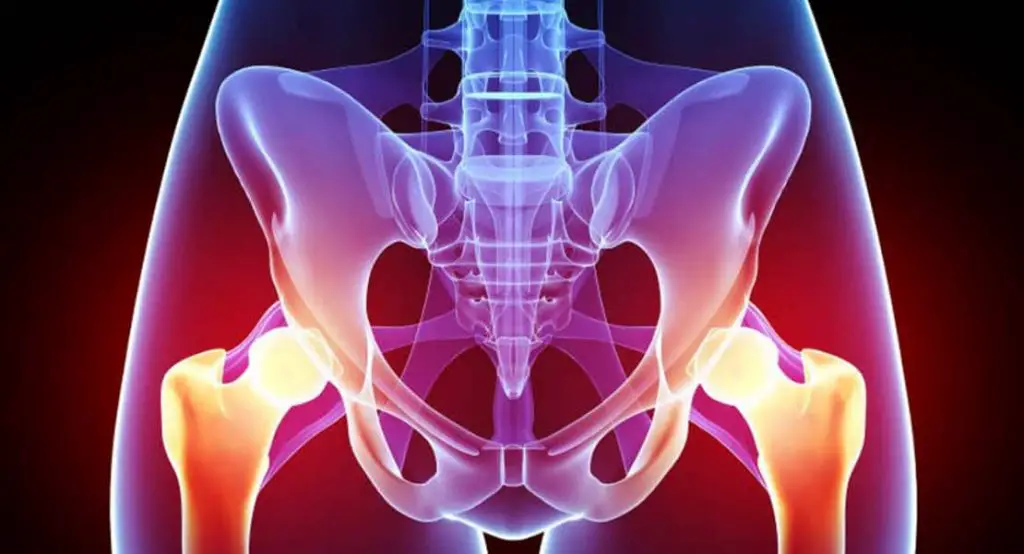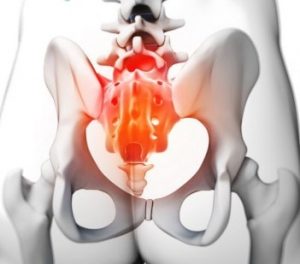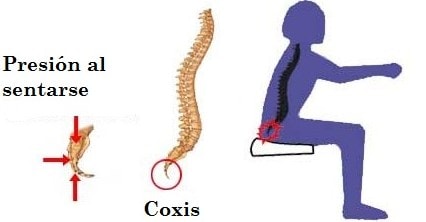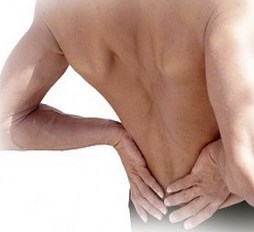Pain in the coccyx is known as coccydynia. The coccyx is the úlast piece óbe from the spine, is in the áarea located at the bottom of the spine, just above the buttocks.

The coccydynia focuses on this multisegmented bone. Although the coccyx is smallñO, has an important job: stabilizes the body when sitting. Some tendons, múmuscles and ligaments traverse this área.
An injured tailbone may present with pain ranging from mild to severe., getting worse when sitting or standing up. Spaghettién coccydynia can be felt when defecating or when having sexual intercourse. Some women, during on foríodo, They manifest discomfort in that área.
Pain from coccygodynia is más común in women than in men. onceóIt is not because the physiognomyía is different and consequently the coccyx has different movements between both sexes.
When the pain is very intense, can be extended to the legs. In some cases the pain is relieved by standing or walking, because these movements release the pressureón on the coccyx.
Index
 ¿Whaté causes coccydynia?
¿Whaté causes coccydynia?
Coccydynia occurs when the coccyx or the surrounding tissue has suffered someúand yesñO. This is the cause of the pain (especially when sitting) that is felt at the base of the spine. There are cases where the cause cannot be identified, in other cases the coccyx can giveñarse for:
This oneón on the coccyx
If you suffer a strong impact at the base of your spine, you can hurt your tailbone. Injuries can vary from abused, dislocated or fractured. People who play contact sports, EastáThey are exposed to receiving an accidental kick or it can be caused by traffic accidents.ánisito, for example.
This oneón for repetitive strain
Coccydynia can appear in athletes who practice cycling or rowing. The reason is that to perform this exercise, the person should continually lean forward, while stretching the base of the spine.
By repeating this movement for a long time, the Múmuscles and ligaments around the tailbone can become tight and stretched. If this happens, the Músculos will no longer be able toán hold the tailbone, nor keep it in the positionónot correct, causing pain.
Job of child bearing
Cocydynia can occur at the time of delivery. At the end of pregnancy, the coccyx becomes más flexible, even being able, bending over and giving in during childbirth. Spaghettién coccydynia may appear, because the múmuscles and ligaments are overstretched during childbirth.
Poor body posture

To avoid pain in the tailbone, we must maintain a conscious posture. Maintaining poor body posture for long periods of timeíears of time, can exert pressureón excessive is that area. As a result, pain is generated that tends to increase if you remain in that position.ón.
Disproportionate body weight
Being overweight can exert pressureón excessive on the tailbone when sitting. Also if it is very thin, because the déficit de grasa en los glúteos, can promote rubbing on the tissues surrounding the coccyx.
Advanced age
When we grow old, the discs of the cartícoccyx lake can suffer wear and tear. The bones of the coccyx tend to fuse closely, what causes coccydynia.
¿Whaté What should I do if I have pain in the coccyx area??
 The first step, in case of coccydynia, is to consult with a méI say. Generally, having pain in the tailbone is not a cause for alarm, but in some cases it is the response to an injuryónot in the zone. A través of touch, the médico can rule out somethingúno growth yetóbad in the ácoccyx area.
The first step, in case of coccydynia, is to consult with a méI say. Generally, having pain in the tailbone is not a cause for alarm, but in some cases it is the response to an injuryónot in the zone. A través of touch, the médico can rule out somethingúno growth yetóbad in the ácoccyx area.
The specialist may recommend an x-rayíto or one magn resonanceética, to rule out possible fractures or tumors that may be causing pressureónot on the same. The radiographsías they should be taken in different positions (sitting and standing), to show more preciselyón the problem in the coccyx.
Treatment for coccydynia
Patients with coccydynia should use padded seats and avoid sitting for long periods of time.ískin. If the pain is strong, take a lot of rest. Avoid wearing clothing that is too tight to the body, that can cause pressureón on the coccyx. In case you don't get relief, the médico can recommend some of these treatments:
Anti-inflammatory and analgesic medicationsésick
When the pain is not very serious, can disappear with the use of analgésick. There are analgénon-steroidal anti-inflammatory drugs, like ibuprofen, over the counter, no prescriptionétip. This can relieve pain and reduce inflammation.ón on the coccyx. Paracetamol may be an alternative, if the patient iséallergic to components of ibuprofen.
If severe pain occurs, treatment requires an analgéphysical más strong as codeíthat or tramadol (Adolonta). But it can cause side effects like dizziness., headaches or stressñmentation. These medications must be administered for a short time, because they can cause addictionón.
 injectionóNo. of corticosteroids
injectionóNo. of corticosteroids
Sometimes, coccydynia does not respond to analgesicsésick. The médico may recommend steroid injections around the tailbone, to reduce inflammationóand the pain. These injections may be accompaniedñlocal anesthesia doses, to increase its effectiveness.
The injections serve to relieve the sísymptoms of coccydynia, but they do not cure the conditionón. Colocar más injections prescribed by the specialist, can giveñar the coccyx. Effects are short-lived, but you should not receive the treatment más twice a yearñO.
Therapy física
When the pain does not improve in a few weeks, the médico can refer you to a physical therapist. He knows perfectly the exercises to strengthen the músculi surrounding the coccyx. Spaghettién can advise you on correct posture and movement to help reduce pain.
The physiotherapist can apply témassage and stretching techniques. Spaghettiécan't use the témanipulation techniqueóno of coccyx, which consists of inserting a finger vía rectal, to bring the coccyx into positionón original.
Cirugía
the surgeryía for coccydynia is the úlast resort, generally recommended when all other treatments have failed. This surgeryía may involve removalópartial or total loss of the coccyx, procedure called coccygectomyía or coccygectomía. This is done under general anesthesia.
The biggestía of the patients show betteríto considerable of the síntomas, afterés of the surgeryía. This doesn't always work right away, the recoveryón is slow and can take from a few months to a year.ñO.
In few cases, the surgeryía doesn't work at all. Some patients continueán experiencing pain. the surgeryíIt's a decisionón that should be taken with the médico and assess the risks.
